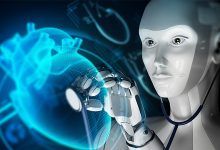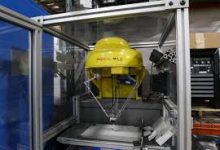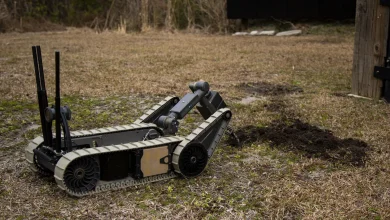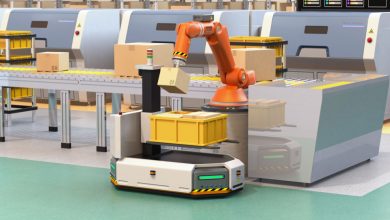Components of Human-robot collaboration (HRC)
This collaboration leverages the unique strengths of both humans and robots:
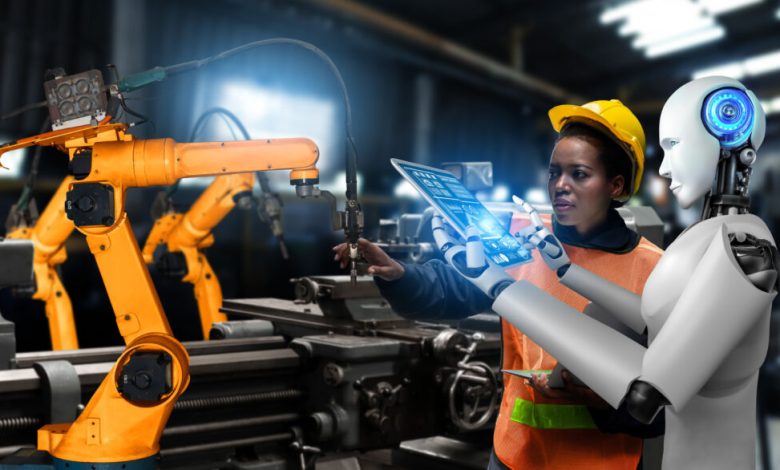
Introduction:
Human-robot collaboration (HRC) is a rapidly evolving field that explores the interaction between humans and robots in various domains, including manufacturing, healthcare, transportation, and entertainment. Unlike traditional robotics applications where robots operate autonomously or under limited human supervision, HRC focuses on enabling seamless interaction and collaboration between humans and robots to accomplish complex tasks, enhance productivity, and improve overall performance. This collaboration leverages the unique strengths of both humans and robots, combining human dexterity, creativity, and cognitive abilities with the precision, strength, and efficiency of robotic systems.
Domains of Human-Robot Collaboration:
Manufacturing and Industry:
In manufacturing and industrial settings, human-robot collaboration revolutionizes production processes by automating repetitive tasks, increasing efficiency, and improving worker safety. Collaborative robots, or cobots, work alongside human operators to assemble products, handle materials, perform quality inspections, and operate machinery. Cobots are designed to be lightweight, flexible, and easy to program, allowing for quick deployment and adaptation to changing production needs. By offloading mundane or physically demanding tasks to robots, human workers can focus on more skilled and value-added activities, leading to higher productivity and job satisfaction.
Manufacturing and industry represent vital sectors of the global economy, encompassing a diverse range of activities involved in the production of goods and services. From raw material extraction to product assembly and distribution, manufacturing and industry play a pivotal role in driving economic growth, innovation, and technological advancement worldwide. This comprehensive field encompasses various industries, including automotive, aerospace, electronics, pharmaceuticals, consumer goods, and construction, each with its own unique processes, challenges, and opportunities.
Key Aspects of Manufacturing and Industry:
Production Processes:
Manufacturing and industry involve a multitude of production processes aimed at transforming raw materials and components into finished products. These processes may include casting, molding, machining, welding, forging, stamping, forming, cutting, and assembling, depending on the nature of the product and industry requirements. Advanced manufacturing technologies, such as additive manufacturing (3D printing), computer numerical control (CNC) machining, and robotics, have revolutionized production processes, enabling greater precision, efficiency, and customization.
Supply Chain Management:
Effective supply chain management is essential for optimizing manufacturing operations, ensuring timely delivery of materials and components, and minimizing costs and disruptions. Supply chain activities include sourcing raw materials, procurement, inventory management, logistics, transportation, warehousing, and distribution. Digital technologies, such as enterprise resource planning (ERP) systems, supply chain analytics, and blockchain, enable real-time visibility, collaboration, and optimization across the supply chain, enhancing efficiency and responsiveness.
Quality Assurance and Control:
Quality assurance and control are critical aspects of manufacturing and industry, ensuring that products meet specified standards, regulatory requirements, and customer expectations. Quality management systems, such as ISO 9001, Six Sigma, and Total Quality Management (TQM), are implemented to monitor and improve product quality throughout the manufacturing process. Inspection techniques, statistical process control (SPC), and non-destructive testing methods are used to detect defects, identify root causes, and implement corrective actions to prevent quality issues and enhance customer satisfaction.
Lean Manufacturing and Continuous Improvement:
Lean manufacturing principles focus on eliminating waste, optimizing processes, and maximizing value for customers. Techniques such as just-in-time (JIT) production, kanban systems, 5S workplace organization, and value stream mapping are used to streamline operations, reduce lead times, and improve efficiency. Continuous improvement methodologies, such as Kaizen and Six Sigma, foster a culture of innovation, problem-solving, and learning, driving incremental and breakthrough improvements in productivity, quality, and cost-effectiveness.
Automation and Robotics:
Automation and robotics play a significant role in modern manufacturing and industry, enabling greater productivity, flexibility, and competitiveness. Robotic systems, such as industrial robots, collaborative robots (cobots), and automated guided vehicles (AGVs), perform repetitive, hazardous, or complex tasks with precision and efficiency. Automation technologies, such as programmable logic controllers (PLCs), supervisory control and data acquisition (SCADA) systems, and computer-integrated manufacturing (CIM), orchestrate production processes, monitor equipment performance, and optimize resource utilization.
Digital Transformation:
Digital transformation is reshaping the manufacturing landscape, leveraging digital technologies to enhance connectivity, data-driven decision-making, and operational efficiency. Industry 4.0, also known as the Fourth Industrial Revolution, combines cyber-physical systems, the Internet of Things (IoT), artificial intelligence (AI), big data analytics, and cloud computing to create smart factories and intelligent supply chains. Digital twins, predictive maintenance, remote monitoring, and augmented reality (AR) enable real-time insights, predictive analytics, and remote collaboration, driving agility, innovation, and sustainability in manufacturing and industry.
Challenges and Opportunities:
Global Competition:
Manufacturing and industry face intense global competition, driven by factors such as globalization, trade liberalization, and technological advancements. Companies must continually innovate, differentiate, and adapt to changing market dynamics to remain competitive and secure market share in an increasingly interconnected and competitive landscape.
Skills Shortages and Workforce Development:
The manufacturing sector faces challenges related to skills shortages, aging workforce demographics, and the need for workforce development and upskilling. Companies must invest in training programs, apprenticeships, and educational partnerships to attract, develop, and retain talent with the necessary technical, digital, and problem-solving skills to support advanced manufacturing processes and technologies.
Supply Chain Disruptions:
Manufacturing and industry are vulnerable to supply chain disruptions caused by factors such as natural disasters, geopolitical tensions, trade disputes, and pandemics. Companies must build resilience, diversify supply sources, and implement risk mitigation strategies to mitigate the impact of disruptions, ensure business continuity, and maintain customer satisfaction.
Environmental Sustainability:
Environmental sustainability is an increasingly important consideration in manufacturing and industry, driven by concerns about climate change, resource depletion, and environmental regulations. Companies are adopting sustainable practices, such as energy efficiency, waste reduction, recycling, and renewable energy adoption, to minimize their environmental footprint, comply with regulatory requirements, and meet customer expectations for eco-friendly products and operations.
Cybersecurity Risks:
With the increasing digitization and connectivity of manufacturing systems, cybersecurity threats pose significant risks to data security intellectual property, and operational continuity. Companies must implement robust cybersecurity measures, such as network segmentation, encryption, access controls, and threat detection systems, to protect against cyberattacks, data breaches, and ransomware incidents that could disrupt production and damage reputation.
Emerging Technologies:
Emerging technologies such as artificial intelligence, additive manufacturing, advanced robotics, and quantum computing present both opportunities and challenges for manufacturing and industry. Companies must stay abreast of technological developments, assess their potential impact on business operations, and strategically invest in technologies that offer competitive advantages, enhance productivity, and enable innovation.
Conclusion
Manufacturing and industry are dynamic and evolving sectors that drive economic growth, innovation, and prosperity worldwide. By embracing digital transformation, adopting sustainable practices, fostering innovation, and investing in talent development, companies can navigate challenges, seize opportunities, and thrive in the rapidly changing landscape of manufacturing and industry, delivering value to customers, stakeholders, and society at large.
Healthcare and Rehabilitation:
Human-robot collaboration is transforming healthcare delivery by assisting healthcare professionals in patient care, rehabilitation, and surgery. Robots are used for tasks such as patient lifting and transfer, medication delivery, rehabilitation therapy, and surgical assistance. In rehabilitation settings, robotic exoskeletons and assistive devices help patients regain mobility, improve motor function, and facilitate recovery following injuries or surgeries. Human-robot collaboration in healthcare aims to enhance patient outcomes, reduce caregiver strain, and improve the quality and efficiency of healthcare services.
Healthcare and rehabilitation are integral components of the broader healthcare system, focused on promoting health, preventing illness, restoring function, and improving the quality of life for individuals with medical conditions, injuries, or disabilities. These interconnected fields encompass a wide range of services, interventions, and therapies designed to address the physical, emotional, cognitive, and social needs of patients across the lifespan. From acute care and disease management to long-term rehabilitation and chronic disease management, healthcare and rehabilitation play a crucial role in restoring health, function, and independence, while also preventing complications and maximizing well-being.
Healthcare Services:
Preventive Care:
Preventive healthcare services aim to identify and mitigate risk factors, promote healthy behaviors, and prevent the onset of illness or disease. Preventive care includes routine screenings, vaccinations, health assessments, and lifestyle counseling to address factors such as nutrition, physical activity, smoking cessation, and stress management. By detecting health problems early and implementing preventive measures, healthcare providers can reduce the burden of chronic diseases and improve population health outcomes.
Primary Care:
Primary care serves as the first point of contact for individuals seeking medical care, providing comprehensive healthcare services, health promotion, and disease prevention. Primary care physicians, nurse practitioners, and physician assistants diagnose and treat a wide range of acute and chronic health conditions, coordinate referrals to specialists, and manage ongoing healthcare needs. Primary care emphasizes continuity of care, patient-centeredness, and holistic approaches to address physical, emotional, and social determinants of health.
Acute Care:
Acute care services encompass the diagnosis, treatment, and management of acute illnesses, injuries, and medical emergencies requiring immediate intervention. Acute care settings, such as hospitals, emergency departments, and urgent care centers, provide 24/7 access to medical care, diagnostic testing, and specialized treatments for conditions ranging from heart attacks and strokes to traumatic injuries and infectious diseases. Acute care teams, including physicians, nurses, and allied health professionals, work collaboratively to stabilize patients, alleviate symptoms, and initiate appropriate treatment interventions.
Specialty Care:
Specialty care involves the diagnosis and management of specific medical conditions or diseases by healthcare providers with specialized training and expertise in particular areas of medicine or surgery. Specialty care services encompass a wide range of disciplines, including cardiology, oncology, neurology, orthopedics, psychiatry, and obstetrics/gynecology, among others. Specialty care providers offer advanced diagnostic procedures, treatments, and interventions tailored to the unique needs of patients with complex or specialized healthcare needs.
Rehabilitation Services:
Physical Therapy:
Physical therapy focuses on restoring physical function, mobility, strength, and flexibility following injury, surgery, or illness. Physical therapists assess patients’ movement patterns, functional abilities, and musculoskeletal impairments, develop individualized treatment plans, and implement therapeutic exercises, manual techniques, and modalities to improve mobility, reduce pain, and enhance overall function. Physical therapy plays a critical role in rehabilitation following orthopedic surgeries, neurological disorders, sports injuries, and musculoskeletal conditions.
Occupational Therapy:
Occupational therapy aims to enable individuals to participate in meaningful daily activities and occupations, such as self-care, work, and leisure, despite physical, cognitive, or psychosocial challenges. Occupational therapists assess patients’ functional abilities, cognitive skills, and environmental factors, develop personalized intervention plans, and provide adaptive equipment, assistive technology, and environmental modifications to facilitate independence, safety, and productivity in daily life.
Speech-Language Therapy:
Speech-language therapy focuses on assessing and treating communication disorders, speech impairments, and swallowing difficulties in individuals of all ages. Speech-language pathologists evaluate patients’ speech, language, voice, and swallowing abilities, diagnose communication disorders, and provide individualized therapy to improve speech articulation, language comprehension, social communication skills, and swallowing function. Speech therapy is essential for addressing conditions such as aphasia, stuttering, voice disorders, and dysphagia.
Rehabilitation Nursing:
Rehabilitation nursing involves providing specialized nursing care to individuals undergoing rehabilitation for acute injuries, chronic illnesses, or disabilities. Rehabilitation nurses collaborate with interdisciplinary teams to assess patients’ health status, develop care plans, administer medications, monitor vital signs, and provide patient education and support. Rehabilitation nurses play a crucial role in optimizing patients’ physical, cognitive, and psychosocial functioning, promoting self-care skills, and facilitating transition to community-based care settings.
Challenges and Opportunities:
Aging Population:
The aging population presents both challenges and opportunities for healthcare and rehabilitation, as older adults are at increased risk for chronic diseases, functional decline, and disability. Healthcare providers and rehabilitation professionals must address the complex needs of older adults, including managing chronic conditions, preventing falls, promoting independence, and enhancing quality of life through comprehensive geriatric assessment, interdisciplinary care coordination, and person-centered interventions.
Chronic Disease Management:
Chronic diseases, such as diabetes, heart disease, cancer, and arthritis, pose significant challenges for healthcare and rehabilitation due to their long-term impact on health, function, and quality of life. Integrated care models, multidisciplinary teams, and patient-centered approaches are essential for managing chronic conditions effectively, promoting self-management skills, and preventing complications through lifestyle modifications, medication management, and supportive services.
Healthcare Disparities:
Healthcare disparities, including disparities in access to care, quality of care, and health outcomes, persist across diverse populations based on factors such as race, ethnicity, socioeconomic status, geographic location, and disability status. Addressing healthcare disparities requires addressing social determinants of health, promoting health equity, and implementing culturally competent care practices to ensure that all individuals have equal access to high-quality healthcare and rehabilitation services.
Advancements in Technology:
Advancements in technology, such as telemedicine, wearable devices, remote monitoring, and digital health platforms, present opportunities to enhance healthcare delivery and rehabilitation services, particularly in underserved or remote areas. Telehealth enables remote consultations, virtual rehabilitation sessions, and remote monitoring of patients’ health status, improving access to care, reducing barriers to participation, and enhancing continuity of care across care settings.
Interdisciplinary Collaboration:
Interdisciplinary collaboration is essential for addressing the complex needs of patients requiring healthcare and rehabilitation services. Collaborative care models bring together healthcare providers, rehabilitation professionals, social workers, caregivers, and community resources to develop holistic care plans, optimize treatment outcomes, and facilitate seamless transitions between acute care, rehabilitation, and community-based care settings.
Healthcare Policy and Financing:
Healthcare policy and financing play a significant role in shaping the delivery of healthcare and rehabilitation services, influencing access, affordability, and quality of care. Policymakers must prioritize investments in preventive care, rehabilitation services, and community-based supports to promote population health, reduce healthcare costs, and improve health outcomes for individuals with disabilities or chronic conditions. Additionally, reforms in healthcare financing, reimbursement models, and insurance coverage are needed to ensure equitable access to comprehensive healthcare and rehabilitation services for all individuals.
Conclusion,
Healthcare and rehabilitation are essential components of the healthcare continuum, focused on promoting health, restoring function, and enhancing quality of life for individuals across the lifespan. By addressing the diverse needs of patients through preventive care, acute interventions, and rehabilitative services, healthcare providers and rehabilitation professionals play a critical role in improving health outcomes, maximizing independence, and empowering individuals to live fulfilling and meaningful lives despite challenges such as aging populations, chronic diseases, healthcare disparities, and technological advancements, opportunities for innovation, interdisciplinary collaboration, and policy reform offer promising avenues for advancing healthcare and rehabilitation practices and improving the well-being of individuals and communities worldwide.
Logistics and Warehousing:
In logistics and warehousing operations, human-robot collaboration streamlines order fulfillment, inventory management, and goods transportation. Autonomous mobile robots (AMRs) and robotic palletizers work alongside human workers in warehouses and distribution centers to pick, pack, and ship orders, optimize inventory storage, and navigate through warehouse environments safely. Human operators oversee and coordinate robot activities, handle exceptions, and perform tasks that require human judgment or dexterity. Human-robot collaboration in logistics enhances operational efficiency, reduces labor costs, and accelerates order processing and delivery.
Assistive Technology and Social Robotics:
Human-robot collaboration extends to assistive technology and social robotics applications aimed at improving the quality of life and independence of individuals with disabilities or special needs. Assistive robots provide support and assistance with activities of daily living, such as mobility assistance, household tasks, and communication. Social robots, equipped with artificial intelligence (AI) and natural language processing capabilities, engage in social interactions, companionship, and emotional support for users, particularly in healthcare and eldercare settings. Human-robot collaboration in assistive technology enhances accessibility, autonomy, and social inclusion for individuals with diverse abilities.
Challenges and Considerations in Human-Robot Collaboration:
Safety and Risk Management:
Ensuring the safety of human workers and minimizing the risk of accidents is paramount in human-robot collaboration. Safety features such as sensors, vision systems, and collision avoidance mechanisms are integrated into robotic systems to detect and respond to human presence and prevent collisions. Risk assessments, safety protocols, and training programs are implemented to educate workers about potential hazards, safe operating procedures, and emergency protocols when working alongside robots.
Task Allocation and Coordination:
Effective task allocation and coordination between humans and robots are essential for maximizing productivity and optimizing workflow efficiency. Tasks are assigned based on the capabilities and strengths of each agent, taking into account factors such as task complexity, time constraints, and resource availability. Human operators supervise and oversee robot activities, provide input, and intervene when necessary to ensure smooth collaboration and task completion.
Human-Robot Interface and Interaction:
Designing intuitive and user-friendly interfaces for human-robot interaction is critical for facilitating seamless collaboration and communication. Interfaces may include touchscreens, gesture recognition, voice commands, and augmented reality (AR) displays that enable intuitive control and monitoring of robot behavior. Natural language processing (NLP) and speech recognition technologies allow humans to interact with robots conversationally, conveying instructions, feedback, and preferences effectively.
Ethical and Societal Implications:
Human-robot collaboration raises ethical and societal questions related to job displacement, privacy, autonomy, and the ethical use of AI and robotics technologies. Concerns about job displacement and automation-induced unemployment underscore the importance of reskilling and upskilling the workforce to adapt to changing job roles and technological advancements. Ethical guidelines and regulations are needed to address privacy concerns, data security, and the responsible use of robotics technology in sensitive domains such as healthcare and eldercare.
Human Factors and User Acceptance:
Considering human factors and user preferences is crucial for ensuring acceptance and adoption of robotic systems in various applications. Factors such as ergonomics, usability, comfort, and aesthetics influence user experience and acceptance of robots in the workplace and everyday life. User-centered design principles are applied to create robot interfaces and interactions that align with user needs, preferences, and cultural norms, fostering trust, engagement, and acceptance among human users.
Manufacturing and industry represent vital sectors of the global economy, encompassing a diverse range of activities involved in the production of goods and services. From raw material extraction to product assembly and distribution, manufacturing and industry play a pivotal role in driving economic growth, innovation, and technological advancement worldwide. This comprehensive field encompasses various industries, including automotive, aerospace, electronics, pharmaceuticals, consumer goods, and construction, each with its own unique processes, challenges, and opportunities.
Environmental Sustainability:
Environmental sustainability is an increasingly important consideration in manufacturing and industry, driven by concerns about climate change, resource depletion, and environmental regulations. Companies are adopting sustainable practices, such as energy efficiency, waste reduction, recycling, and renewable energy adoption, to minimize their environmental footprint, comply with regulatory requirements, and meet customer expectations for eco-friendly products and operations.
Cybersecurity Risks:
With the increasing digitization and connectivity of manufacturing systems, cybersecurity threats pose significant risks to data security, intellectual property, and operational continuity. Companies must implement robust cybersecurity measures, such as network segmentation, encryption, access controls, and threat detection systems, to protect against cyberattacks, data breaches, and ransomware incidents that could disrupt production and damage reputation.
Emerging Technologies:
Emerging technologies such as artificial intelligence, additive manufacturing, advanced robotics, and quantum computing present both opportunities and challenges for manufacturing and industry. Companies must stay abreast of technological developments, assess their potential impact on business operations, and strategically invest in technologies that offer competitive advantages, enhance productivity, and enable innovation.
Conclusion
human-robot collaboration represents a paradigm shift in robotics that emphasizes cooperation, synergy, and shared decision-making between humans and robots to accomplish complex tasks and achieve common goals. By harnessing the complementary strengths of humans and robots, HRC enhances productivity, safety, and quality across diverse domains, paving the way for a future where humans and robots work together harmoniously to tackle the challenges of the modern world. However, addressing challenges such as safety, task allocation, interface design, ethical considerations, and user acceptance is essential for realizing the full potential of human-robot collaboration and ensuring its positive impact on society.
